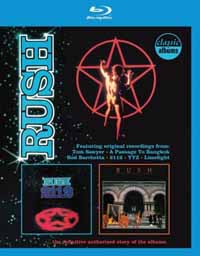The history of Rush is getting loads of attention these days. Rush: Beyond The Lighted Stage, released in June 2010 to much acclaim, is an outstanding and thorough documentary that traces the band’s beginnings, their ups and downs, and right up to present day. Coming along a couple of months later, Classic Albums: 2112 & Moving Pictures provides a different take, one that may be more intriguing to musicians inspired by the band and the music from two pivotal albums.
Testimonials from Rolling Stone magazine’s David Fricke, DJ Jim Ladd, drummer Taylor Hawkins of the Foo Fighters and Ed Robertson of Barenaked Ladies add credence to the group’s ascension and influence. Meanwhile, producer Terry Brown, manager Ray Danniels, A & R guru Cliff Burnstein, and band members Alex Lifeson, Geddy Lee and Neil Peart tell the story. As with many Classic Albums segments, we go back to the beginning when Rush was a struggling Canadian power trio.
As the group worked tirelessly to establish themselves, Lifeson and Lee began writing more progressive music. Original drummer John Rutsey, however, was, in the words of Lee, “a rock and roll purist” and a diabetic, which made extensive touring problematic. When Rutsey, who died in 2008, was replaced by Neil Peart, Rush began to create their unique sound. Peart was not only a dynamic drummer (claimed by many to be the world’s best); he also had a penchant for writing lyrics.
Caress of Steel, the group’s third release, was a huge leap artistically, with longer, conceptual pieces built around Peart’s cerebral, Ayn Rand-inspired lyrics. Unfortunately, the record fell flat and nearly ended the band’s career. Encouraged to become more commercial, the band members explain how they felt compelled to go for broke with an even more ambitious project: 2112. With one side dedicated to Peart’s dystopian tale and the other filled with unrelated songs, 2112 marked the beginning of the Rush fans grew to know and love.
At this point, we get an intimate view into how the album was constructed. Brown works the console and Lifeson, Lee and Peart revisit their parts. Like a musician’s dream, the pieces come together magically and organically. Most of all, we learn 2112 brought Rush the freedom to do what they want. New ideas emerged, experiments took place, more sounds were added. Altogether, the music retained degrees of complexity, but it sounded more streamline, setting the stage for 1980’s Moving Pictures.
As the band tells it, Moving Pictures was recorded fairly quickly in an ideal environment. Instrumental tracks like “YYZ” (airport code for “coming home”) allowed the group to stretch out and parlay their musicianship. But it was “Tom Sawyer” that would become the quintessential Rush song. Naturally, the story fleshes out the song’s anatomy – from its famous synthesizer opening to Peart’s drumming (which pretty much drives the song for the first 90 seconds or so) to Lifeson’s quirky lead to Lee’s measured vocal.
Almost an hour’s worth of bonus material features in-depth segments on the construction of 2112. We learn that Hugh Syme, a graphic artist, was pulled in to the studio to play random sounds on a mellotron, forming the spacey opening sequence of 2112. The whole band follows up, playing their individual parts. “Tom Sawyer” is also deconstructed. At one point, Brown plays an alternate version with a faster tempo – reinforcing the original’s lyrical finesse and rigid foundation.
It’s here where band members also touch on their musical (Cream, Jimi Hendrix, The Who, Led Zeppelin) and literary (in Peart’s case, the aforementioned Ayn Rand and science fiction writer Samuel R. Delany) influences, as well as each other. For some reason, the bonus material on these Classic Albums discs are more alluring than what’s in the original film. Just makes you curious what else they left on the cutting-room floor.
As Fricke cleverly observes, it’s a feat to be able to make one great record, much less two. In Rush’s case, Classic Albums: 2112 & Moving Pictures illustrates how the band’s two landmark albums, created under different circumstances, contributed heavily to their evolution and longevity. In the midst of winding up a tour playing Moving Pictures in its entirety, Rush’s long-running adventure is still a marvel and a watershed in a world overflowing with mediocrity. Let’s hope they have a third or fourth one we can celebrate in years to come.
~ Shawn Perry




















